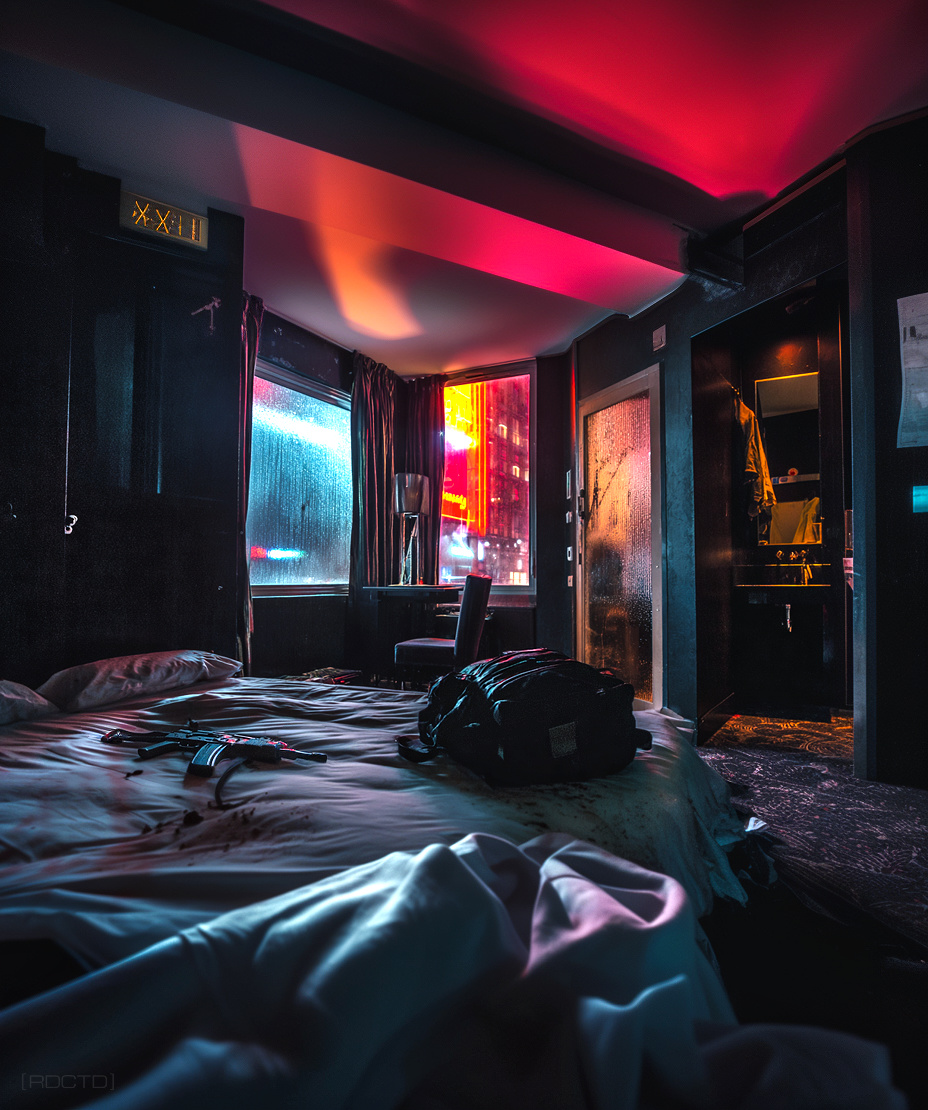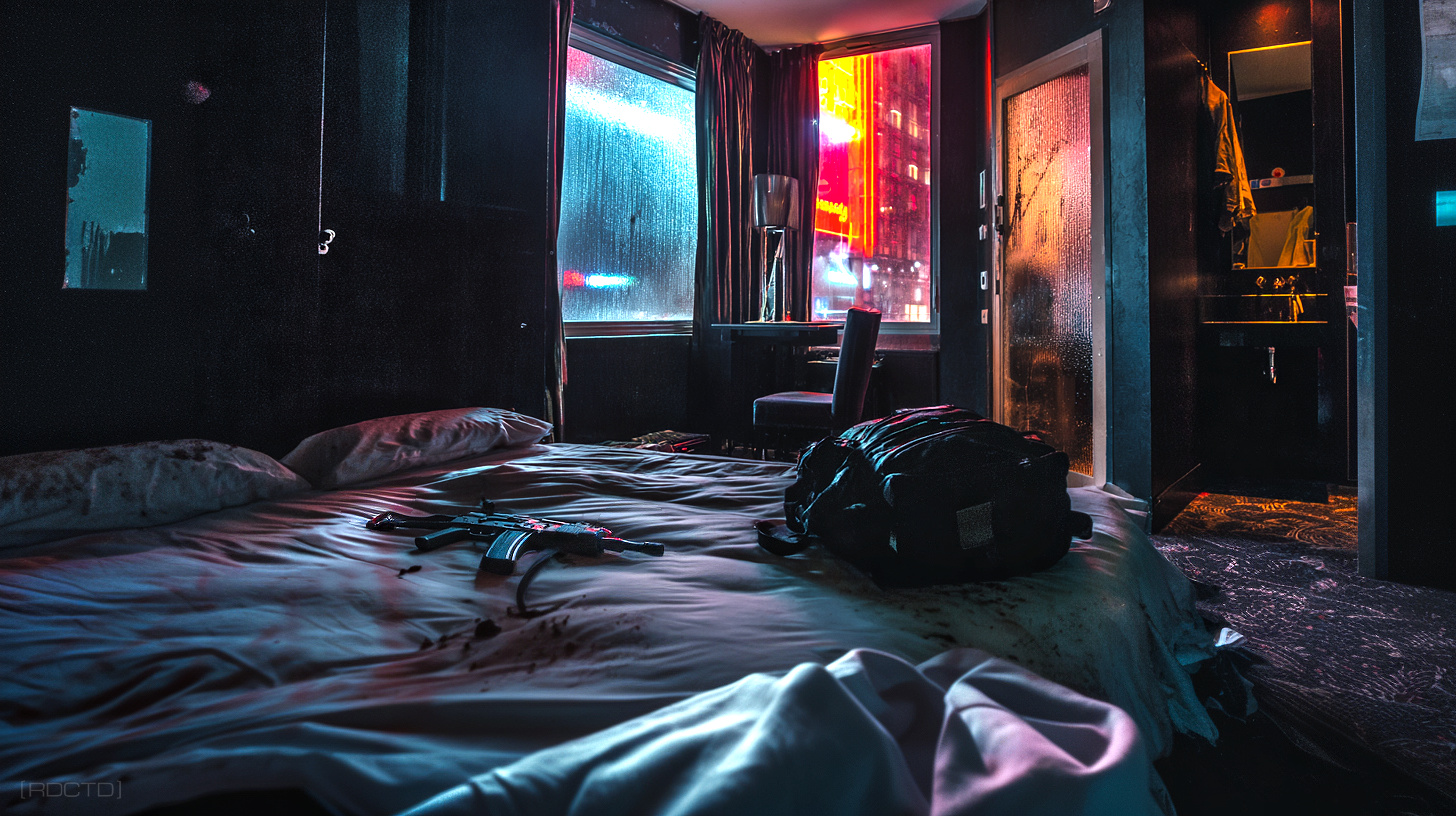 A tradecraft listed guide to securing an insecure hotel stay. Tactics to hardening an unsafe / decrepit / unreliable and otherwise high-risk rooms, reduce general vulnerability, and exfil / escape measures.
A tradecraft listed guide to securing an insecure hotel stay. Tactics to hardening an unsafe / decrepit / unreliable and otherwise high-risk rooms, reduce general vulnerability, and exfil / escape measures. ![]()
A hotel room isn’t your territory, it’s your temporary perimeter.
![]()
Operative Mindset
Think of this as a trained reflex set. You’ll observe without obsession, plan without paralysis, and act with calibrated urgency. Adopt an assume-compromise posture – presume at least one layer (digital, physical, or human) can fail, and structure choices so a single failure doesn’t ruin your day.
That means prioritizing PERSEC, escape, and detection over permanence (exit-first thinking), avoiding theatrical risk-taking, and keeping a low signature so you aren’t worth the trouble. Stay curious and skeptical – question explanations that come too easily, and watch for patterns that repeat. Keep a short list of go/no-go triggers (sudden staff insistence on entry, unexplained noise at night, a door that won’t lock, and so on).
![]()
![]()
![]()
Broken or Missing Door Lock / Latch
A nonfunctional or absent door lock is the most common and dangerous flaw in low-tier accommodations. Treat it as a structural failure, not an inconvenience. Your first line of action is to create resistance and delay.
A portable door lock or “travel latch” is ideal – it anchors directly into the door strike and prevents inward opening even if the main latch is compromised. A collapsible door brace or under-knob jammer works well for solid doors. If you’re improvising, wedge a heavy suitcase or chair under the doorknob, loop a belt or strap from the knob to a fixed anchor (like a desk leg or radiator), and position a secondary barrier, such as a table, directly behind the door.
![]()
![]()
![]()
No Chain, Peephole Missing or Broken
A missing or damaged peephole and door chain eliminates your ability to verify before you engage, which is a fundamental security failure. You never open a door blind. Start by substituting visibility.
Use your phone’s front-facing camera angled through the door gap near the frame to see who’s outside, or a compact mirror if you’re running low-tech. If the hallway light is poor, switch on your own to improve the contrast on your screen. For improvised visual coverage, place a reflective surface (metal travel mug, sunglasses, or even a small pocket mirror) at an angle on the floor to catch movement outside.
![]()
![]()
![]()
Door Frame / Strike Plate Rotten or Easily Kicked In
A lock is only as strong as the frame anchoring it. In many low-cost or older hotels, that frame is soft wood, poorly mounted, or even cracked from prior forced entry. A compromised strike plate or splintered frame means one solid kick will defeat the entire door, no matter how strong your lock looks.
First, assess integrity. Gently tug and push near the lock and hinges – if the door flexes, assume it’s weak. Immediate hardening starts with internal bracing. Move the heaviest available furniture (dresser, desk, or table) directly against the door from the inside. Reinforce with a strap, belt, or luggage tie looped between the doorknob and the furniture base to resist sudden force.
![]()
![]()
![]()
Keycard Security and Unauthorized Duplicate Access
Electronic keycard systems look modern, but they’re often the weakest part of a hotel’s access control. Many low-end or poorly managed hotels reuse cards, fail to deactivate old ones, or use outdated magstripe systems that can be cloned in seconds with a $20 reader.
This means someone who once stayed in your room – or anyone who handled your card – could have access without you ever knowing. Upon check-in, request that the front desk recode the room lock rather than just issuing a new card; this ensures all prior credentials are invalidated. When you return to your room, pay attention to subtle signs of tampering – repositioned items, lights left on, windows unlocked.
![]()
![]()
![]()
Broken / Unlockable Window or Balcony Door
A compromised window or balcony door is an open invitation for entry, surveillance, or theft. In low-security hotels, these are often the most neglected vulnerabilities: warped frames that don’t seal, corroded locks, sliding glass doors that lift straight off the tracks.
The first step is to deny movement. If it’s a sliding unit, insert a solid barrier – a metal rod, wooden dowel, or the handle of a broom – into the bottom track to prevent it from sliding open. For hinged windows, wedge folded cardboard or a rubber doorstop between the sash and the frame to freeze it in place. Curtains should stay closed at night, but don’t let them telegraph occupancy – use partial coverage that blocks visibility from outside without plunging the room into darkness.
![]()
![]()
![]()
Staff Behavior / Unauthorized Staff Access
A disloyal or criminal staff member is one of the most underestimated threats in any insecure hotel. Unlike external intruders, they already have keys, uniforms, and plausible reasons to knock. The danger isn’t just theft – it’s surveillance, covert access, or planting devices while you’re away.
Treat every interaction professionally but cautiously. Keep your “Do Not Disturb” sign posted when you don’t require service, that single step cuts most unauthorized entries. If anyone requests access – “maintenance,” “security check,” or “housekeeping audit” – confirm through the front desk via the in-room phone before unlocking. Note the name and time of every staff entry in your notes or phone.
![]()
![]()
![]()
Poor Exterior Lighting and Unsafe Approach Path
A poorly lit hotel perimeter or approach path creates prime conditions for ambush, tailing, and opportunistic assault – especially during arrival or late-night movement. Criminals and opportunists use darkness, cluttered parking areas, and blind corners as concealment zones.
Before you even book, check satellite imagery or street photos to understand the layout. Once on-site, make a daylight reconnaissance: identify primary and secondary routes to the lobby, your vehicle, and emergency exits. At night, avoid blind approach vectors – stay within illuminated zones, walk near building walls instead of open lots, and keep your head on a swivel while maintaining hands free and visible.
![]()
![]()
![]()
Fire Hazards, Blocked Exits, or Poor Emergency Signage
When you stay in a low-grade hotel, the threat isn’t always from human intent – sometimes it’s the building itself. Fire hazards, obstructed exits, and missing signage can turn a small incident into a fatal trap.
The first thing an experienced operative does upon entering any room is run an emergency check. Locate the nearest stairwell (avoid relying on elevators too much), count the number of steps and doors between your room and that exit, and identify a secondary egress route in case the first is blocked. Many substandard hotels disable alarms to avoid nuisance calls or let exit paths become cluttered with storage – don’t assume they’re functional.
![]()
![]()
![]()
Insecure Wi-Fi and Device Exposure
Hotel networks are some of the most hostile digital environments you’ll ever connect to. Open or semi-secured Wi-Fi systems invite interception, credential theft, and network mapping by anyone with basic software.
In budget or neglected hotels, routers are rarely patched, guest isolation is disabled, and access logs are practically nonexistent – meaning every other guest shares your digital hallway. Treat hotel Wi-Fi as a compromised network. Avoid logging into sensitive accounts (banking, work email, government portals), and never transfer classified or operational files over it. Instead, use a personal hotspot via your phone or a portable cellular router.
![]()
![]()
![]()
Room Layout That Lets an Intruder Get to You Quickly
An open-plan room where the bed or work area sits in full view of the door hands an intruder immediate access and removes every second you’d need to react. The goal is to create defensible space – simple, quick obstacles and sightlines that force an approaching threat to slow down, show themselves, and give you time to detect, deny, and escape.
On arrival, orient the bed so you have a clear line-of-sight to the entry and any connecting doors. If that’s impossible, move a chair, luggage, or small table to form a visual funnel between the door and the inner room. Use existing fixtures (desk, dresser) to build a partial choke point that an attacker must negotiate rather than sprint past.
![]()
![]()
![]()
Hiding Valuables Externally for Maximum Security
This is moving the asset away from the obvious search space – the bedroom, drawers and the safe – and into locations most thieves and hotel staff won’t consider to check. Think like an operative: avoid predictable conceals, use the environment to create plausible deniability, and make retrieval low-risk and low-profile.
Good external hides are out-of-the-way, semi-permanent micro-sites that blend with routine maintenance or building fixtures – the underside of a balcony railing, the hollow base of a large hallway planter, the shadow side of a locked HVAC unit, or a sealed container tucked under a heavy vending machine (where access requires tools or time).
![]()
![]()
![]()
Being a Target: Behavior and Observable Routines
Flashy behavior and predictable routines paint a target on your back. Showing expensive watches, jewelry, high-end luggage, or loudly announcing travel plans creates both opportunity and motive for theft or focused surveillance. Equally dangerous is predictability – same café run every morning, identical arrival/departure times, or posting your location on social media.
Reduce your signature. Dress down, use unbranded luggage or covers, store valuables out of sight, and vary your routes and schedules. Don’t advertise presence or absence – avoid live social media check-ins, and never leave obvious stacks of cash or electronics visible through windows or on nightstands. Split valuables (some on your person, some hidden in luggage), use low-profile concealments (inside toiletry cases, sewn pouches), and keep ceremonies – checkouts, pickups, meetings – informal and staggered so there’s no single predictable moment an observer can exploit.
![]()
![]()
A hotel room is never safe. It’s just safer than outside, for now.
![]()
Securing an insecure hotel room is a practice in layered defenses: observe, deny, delay, and have an exit. Treat every room like a temporary operating base. Assume someone may try to exploit a weakness, create delays and detection. Adapt tradecraft principles – make and keep options open, reduce signatures, and always plan dynamic egresses.
![]()
// Don’t sleep where your plan ends.
[INFO : [OPS] The Warfare Ruin Hotel]
[OPTICS : Budapest, Hungary]
![[RDCTD]](https://rdctd.pro/wp-content/uploads/RDCTD-Covert-Operative-Tradecraft-Guide-LOGO-tk.png)
![[RDCTD]](https://rdctd.pro/wp-content/uploads/RDCTD-Covert-Operative-Tradecraft-Guide-LOGO-mobile.png)


